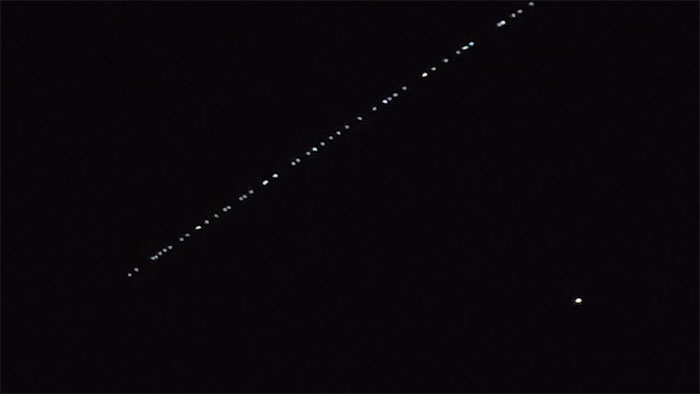SpaceX has expressed anger over a report from the U.S. government concerning the risk of Starlink satellites falling to Earth, which could result in fatalities and pose a threat to the aviation industry.
“The sky may not fall on our heads, but satellites might,” is the grim scenario presented by the Federal Aviation Administration (FAA) in a report dated September 22, which was published in October.
The report submitted by the FAA to Congress indicates unfavorable conditions for SpaceX.

SpaceX strongly responded after the U.S. aviation agency reported on the threat posed by Starlink satellites from the company. (Illustrative image: Numerama).
The report reveals that by 2035, if SpaceX significantly increases the number of satellites in its Starlink system, there could be debris falling to Earth after these devices re-enter the atmosphere at the end of their operational life, with projections of up to 28,000 pieces per year.
Estimates indicate that the number of people on the ground who could be injured or killed by satellite debris could lead to one person being affected every two years.
This threat would also weigh on the aviation sector, but to a very low degree. Research shows that the probability of an aircraft being hit by debris large enough to cause it to crash would be 0.07% by 2035.
SpaceX has been working for years to establish a massive “satellite constellation” in low Earth orbit, named Starlink.
From 2019 to October of this year, SpaceX has launched over 5,200 Starlink satellites. In the future, the company plans to establish a network of 42,000 satellites worldwide to transmit internet from space to Earth.
However, there is a significant limitation: the lifespan of each Starlink satellite is only 5 years. Therefore, many satellites have already ceased operations and many more will in the future.

Starlink satellites moving in low orbit as seen from Earth. (Image: KWCH).
SpaceX’s strategy is to bring them into the atmosphere to burn up completely since they are very close to Earth. This is a preferred option over placing these devices into a debris orbit, a solution often used for telecommunications satellites.
SpaceX’s Response
SpaceX has expressed strong disagreement with the FAA’s analysis. The company stated that it is mistaken to believe that thousands of pieces of debris will bombard the Earth and kill people.
The official website of the American company stated: “Starlink satellites are designed to burn up completely when they re-enter the Earth’s atmosphere, meaning these devices pose no risk to human life or property on the ground. Over 325 satellites have been destroyed this way.”
The FAA concluded this based on a report from a nonprofit organization under the Aerospace Corporation, which is federally funded.
SpaceX accused this organization of using an outdated study from the National Aeronautics and Space Administration (NASA) to assess the risks associated with Starlink satellites during their re-entry into the atmosphere.
“The Aerospace Corporation provided the FAA with a distorted analysis, including bizarre, irrational, and inaccurate claims about the risks posed to eliminate Starlink from the public and the aviation sector,” SpaceX criticized.
At the same time, the company highlighted a lack of communication between the two parties that led to these erroneous assessments.
SpaceX blamed the FAA for accepting the report without any review, subsequently distributing this inaccurate information to Congress.
The American company retaliated, striking back at the agency with a statement that the FAA’s simple acceptance of the Aerospace report without questioning or thorough evaluation raises concerns about the FAA’s technical capabilities in responsibly assessing and regulating this issue.
So far, there seems to be no report of debris from Starlink satellites found on the ground, let alone any injuries or fatalities.





















































